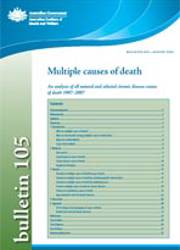Discussion
The analyses presented here highlight the underestimation of the contribution that selected chronic diseases make to overall mortality when cause of death is described using the underlying cause only. This is particularly true for diabetes and chronic and unspecified kidney failure.
The analyses in this bulletin do not suggest that routine analyses of mortality (by underlying cause of death) should be replaced by those based on multiple causes of death. Rather, multiple cause analyses complement those using underlying cause only and provide useful additional information.
There is no standard method to analyse multiple causes of death. The analyses undertaken for this bulletin used specific disease categories. A multiple cause of death approach may be better suited using specific disease categories than for broad disease categories or all deaths. Patterns of commonly co-occurring conditions between, for example, cardiovascular diseases and all endocrine diseases do not offer the same value of insight as say between coronary heart disease and diabetes.
Multiple causes of death data can be useful for examining the quality of certification practices. Clinical accuracy and completeness of the clinical detail can be explored by using all the disease information provided in the death certificate. Assessment of the type and frequency of reporting non-specific and ill-defined causes can be used to target areas for improvement, for example, in the Cause of death certification booklets produced by the ABS to guide medical practitioners in completing death certificates. An analysis of the reporting practices of certifiers was not in the scope of this bulletin or any AIHW uses of the cause of death data.
Useful additional analyses using multiple causes of death include investigations at different broad age groups. For example, an account of the types of contributing causes of death among people of working age would enhance understanding of the burden of mortality as well as provide insight into emerging health trends in relation to co-morbidities among this population group.
The strength of the association between contributing causes of death can be calculated. These analyses can show whether a specific disease is more or less likely to contribute to deaths involving a disease of interest compared with another disease, or all other diseases. These sorts of analyses can be useful for guiding detailed epidemiological research, for example, to determine appropriate intervention points for the prevention of disease.
Despite the broader insight into patterns of mortality offered by the analyses provided in this bulletin, there are some data limitations. These include:
- Information from death certificates does not enable an understanding of the prevalence of co-morbidities in the population, only the diseases the person had that were instrumental in causing death.
- Certifiers' opinions of the cause of death can change over time according to new knowledge about conditions. For example, there is an increased recognition among certifiers of the risk that some chronic diseases contribute in the development of other conditions, such as diabetes being a risk factor for cardiovascular disease (Cheng et al. 2008). It is difficult to assess the propensity of certifiers to include all strongly suspected and commonly related conditions on the death certificate as compared with only including those that pathologically influenced the death.
- The mortality data available for monitoring and surveillance and statistical analysis rely on the diligence of certifiers to accurately and completely depict the conditions that were instrumental in causing the death; there are few evaluations available concerning the completeness and accuracy of death certification for Australian mortality data.
- Similarly, the introduction of, or changes to, existing policy can influence the information reported on death certificates. Changes in certification practices and to coding processes can influence the number and type of causes contributing to death (see the results section for example, of deaths involving dementia and Alzheimer disease). Variation in certification practices refers to changes in the way that a certifier documents the types of diseases that caused the death. It is difficult to evaluate these changes unless they result in measurable change to statistical patterns of causes of death.
- Completeness of death certification can also affect the reporting of contributory causes. For example, analysis of people registered for treatment for chronic kidney disease has shown that the involvement of this disease in their death is not always recorded in the deaths data, despite the severity of the disease (AIHW 2011).
- Patterns of mortality (based on both underlying and multiple cause of death data) can vary for many reasons, including changes to the coding system and coding instructions; changes in certification practices and awareness of associations between diseases; changes in policy, and of course, changes in the actual occurrence of the disease. Each of these aspects needs to be considered in analyses of multiple causes of death data to understand trends.
- Multiple causes of death data do not imply causality between conditions. Although the WHO-recommended format of the death certificate requires that the certifier indicate the duration of each reported condition for immediate, intervening and underlying causes, this information is not available in the coded data nor is it available for the causes on the death certificate that are considered to make a significant contribution to the death. Therefore only associations, rather than causal relationships, between different conditions can be examined.



